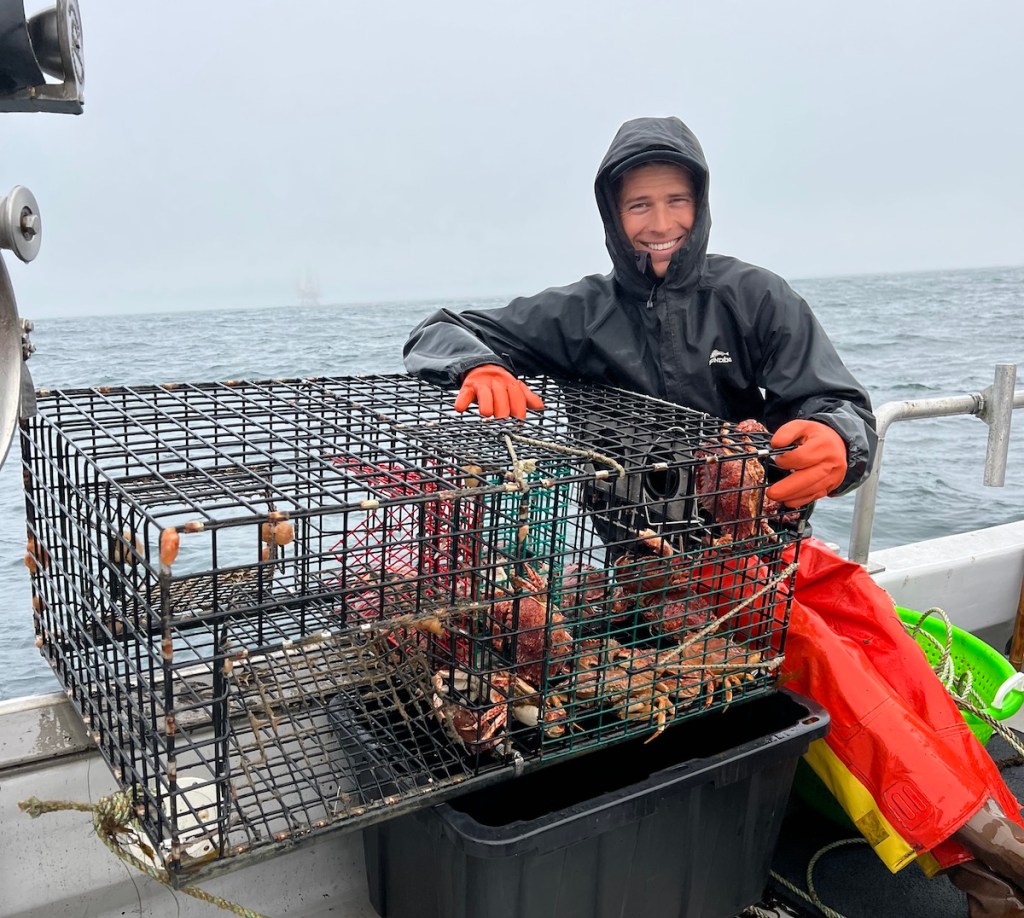Courtesy Garrett Rose
Roughly 17 miles off Morro Bay, the U.S. government plans to lease an area just smaller than Hong Kong to wind energy companies to create more electricity than Diablo Canyon nuclear power plant’s 2,200 megawatts. Though the ocean may seem vast and fathomless, the proposal has already identified that commercial ships and the U.S. Navy are active in the 376-square-mile area — a fact that required a negotiation with the Navy Secretary. It has also set off alarm bells for fishermen in Santa Barbara and in neighboring harbors.
Power turbines harnessing the wind grow larger every year, with the most powerful the height of the Statue of Liberty with a wingspan of two-and-a-half football fields. They’re being tested in Denmark and the Netherlands, rated to generate 15 megawatts of power, enough to run 18,000 European households. The “sweep” of the turbine blades encompasses an area equal to the size of Dwight Murphy Field, or 10 vertical acres in the sky.
The first of several environmental assessments in the United States is being conducted by the Bureau of Ocean Energy Management (BOEM). So far, no leases have been sold. Another set of studies will be done post-leasing by several companies, who will use buoys to determine weather and wind conditions, as well as to conduct bathymetric (underwater topography) studies as the giant floating turbine construction projects continue down the development and approval process including environmental studies.
Congressmember Salud Carbajal, a staunch champion of Morro Bay’s offshore wind project, negotiated an agreement with Navy Secretary Kenneth Braithwaite when conflicting uses threatened to scuttle the project in 2020. The Navy had found that windfarm operations in federal waters could affect aircraft systems and training preparation for overseas deployments.
Though Carbajal persuaded the Navy of the importance of wind-generated energy for the West Coast, Braithwaite stated the risk to training missions was “acceptable” as long as there was a moratorium on further windfarms in military operating areas. Carbajal called it a win, saying, “Offshore wind holds incredible promise as a means to tackle climate change while also creating economic opportunity, and the Central Coast is uniquely poised to reap the benefits.” All told, the wind is expected to generate 2,924 megawatts, enough to power more than a million homes.
California’s state waters that lie two-and-a-half miles off Vandenberg Space Force Base may be the testing grounds for several wind platforms. The area is notoriously windy; more than 50 shipwrecks lie under the waves, including the seven destroyers that went off course in heavy fog in 1923 and ran aground at Point Honda, killing 23 seamen.
Two companies have applied for permits from the State Lands Commission to moor four platforms each, connected together with cables, and an energy cable conveying electricity onshore to substations on the base. The CADEMO project, which would lie off Point Honda, is by Cierco Projects Corporation of Palm Springs. They propose to test two platform designs for turbines of 12-15 megawatts. Ideol U.S.A., owned by a French company that has floated wind turbines off the French coast since 2018, plans to install and then decommission floating barges holding 10-megawatt turbines moored to the seabed off Point Arguello.
The Vandenberg projects are in about 300 feet of water, said Chris Voss, president of the Commercial Fishermen of Santa Barbara, and the federal leases are in waters 3,000-4,200 feet deep. “We wonder about how those things are engineered,” Voss said of the floating islands. “As a group, because of our experience on the water, we recognize that the ocean can be incredibly violent and dangerous. If one broke loose, would it careen into another? Those things are mammoth, absolutely enormous.”
The integrity of the structures and their seabed anchoring on California’s outer continental shelf isn’t all that concerns the fishermen’s collectives in Santa Barbara, San Luis Obispo, and Ventura. They are watching all the wind developments closely for potential effects on their industry. For one, they anticipate that the cables anchoring each floating turbine and linking them to each other will pose issues for the fleet. A transit zone between them would be needed, Voss said.
“We are also seriously concerned about the environmental impacts,” Voss added. The fishermen worry the turbines may catch the wind in a manner that disrupts coastal upwelling. “This is the natural dynamic that creates the nutrient-rich water that feeds the food chain,” Voss explained. “We’ve got to get off carbon,” he said, “no argument. We understand that. Our argument is that this should be done in a methodical and organized way.” Voss was concerned that President’s Biden’s proposal to add 30,000 megawatts of offshore power by 2030 was pushing the edge of a technology insufficiently studied for the deep waters of the Morro Bay projects.
The fishermen fully expect to lose the fishing grounds where they’d caught halibut, sable fish, spot prawn, salmon, sea cucumber, Dungeness crab, and other fish by a variety of methods. And they expect to be compensated, as they were when offshore data cables from across the Pacific came into San Luis Obispo County, making portions of the sea floor off-limits and crowding the port of Morro Bay with ships and barges to service the installation.
Big money is involved here, just as it was when offshore oil leases were sold in the 1950s. “The wind energy corporations just gave the feds $4.2 billion for leases on the East Coast,” said Voss, predicting, “This is going to be a long process.”
The comment period on the federal lease plan has been extended to May 16, and BOEM expects the first lease analyses to be completed in 2023. To learn more or comment on the project, visit boem.gov.
Support the Santa Barbara Independent through a long-term or a single contribution.

